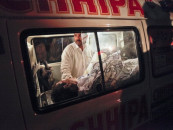Polio cases in Pakistan rose by 73% during intense periods of civil conflict: study
It stresses that polio eradication campaign has overcome violence before

PHOTO: FILE
The VOA said polio has gone from infecting over 1,000 children per day to just a handful of cases per year over the past three decades. But it remains a threat to unvaccinated children everywhere as long as the disease circulates anywhere.
England announces additional support for Pakistan
Pakistan, Afghanistan and Nigeria are the last three countries on earth that have not stopped the disease from spreading and all three suffer from violent militant attacks.
However, the polio eradication campaign has overcome violence before. Vaccinators have brokered ceasefires in El Salvador, Lebanon, Sri Lanka, the Democratic Republic of the Congo and elsewhere, all of which are now polio-free.
“The question is, is the effect (of insecurity in Pakistan) big enough to really be a barrier to polio eradication?” asked lead author Amol Verma at the University of Toronto.
“Our study suggests that yes, it is,” Verma said.
Verma and colleagues looked at violence more generally while polio vaccination teams have been singled out for attacks, including a mother and daughter in Quetta earlier this month.
They studied casualty figures from terrorist attacks, suicide bombings, drone strikes and gun battles tallied from news reports. They later compared the data to monthly, district-by-district statistics on new polio cases, and data from polio campaigns on the numbers of children reached.
Although conflicts sometimes forced the cancellation of a campaign, the violence had an impact even when vaccinators continued their work.
“Even when vaccination campaigns were carried out in times of high insecurity, the vaccination coverage was about 5 per cent lower than in times of low insecurity,” Verma said.
Health workers have been "rather heroic in trying to reach people in these very difficult-to-reach regions," he added, explaining that vaccinators would reach everywhere they could, but knew some areas were too dangerous.
Those unreachable areas added up to over quarter-million children not getting vaccinated, and a 73 per cent increase in newly paralysed children.
“Even though it’s only a 5 per cent reduction in vaccination rates, that is enough to allow the virus to continue to be circulated and transmitted,” he said.
Fresh poliovirus case surfaces in Balochistan
Campaign officials sometimes falsify records, and population data in Pakistan are limited, the study authors also acknowledge.
“Despite data collection issues and the inherent difficulty of accurately quantifying levels of insecurity and its impact, the authors have statistically shown that a causal relationship between insecurity and polio incidence exists,” said Richard Sullivan, co-director of the Conflict and Health Research Group at King’s College London, who was not involved with this study.
This story originally appeared on the VOA.



















COMMENTS
Comments are moderated and generally will be posted if they are on-topic and not abusive.
For more information, please see our Comments FAQ